Integrated Kinetic Fins for Western Facades in Territories with Low Solar Altitudes
Abstract
1. Introduction
2. Methodology
2.1. Description of the System
2.1.1. Conventional Kinetic Fins (CKF)
2.1.2. Parametric Kinetic Fins (PKF)
2.1.3. Integrated Kinetic Fins (IKF)
2.2. Performance Metrics
2.2.1. Contrast and Uniformity
2.2.2. Illuminance Values
3. Modelling and Optimization Process
3.1. Dimensions Adjustment for the Fins
3.2. Daylighting Distribution Using IKF
4. Results and Discussion
5. Conclusions and Future Studies
Author Contributions
Funding
Data Availability Statement
Conflicts of Interest
References
- Bugeat, A.; Beckers, B.; Fernández, E. Improving the daylighting performance of residential light wells by reflecting and redirecting approaches. Sol. Energy 2020, 207, 1434–1444. [Google Scholar] [CrossRef]
- Compagnon, R. Solar and daylight availability in the urban fabric. Energy Build. 2004, 36, 321–328. [Google Scholar] [CrossRef]
- Lim, Y.-W.; Kandar, M.Z.; Ahmad, M.H.; Ossen, D.R.; Abdullah, A.M. Building façade design for daylighting quality in typical government office building. Build. Environ. 2012, 57, 194–204. [Google Scholar] [CrossRef]
- Eltaweel, A.; Su, Y. Parametric design and daylighting: A literature review. Renew. Sustain. Energy Rev. 2017, 73, 1086–1103. [Google Scholar] [CrossRef]
- Hopkinson, R.G. Glare from daylighting in buildings. Appl. Ergon. 1972, 3, 206–215. [Google Scholar] [CrossRef]
- Urbano Gutiérrez, R.; Du, J.; Ferreira, N.; Ferrero, A.; Sharples, S. Daylight control and performance in office buildings using a novel ceramic louvre system. Build. Environ. 2019, 151, 54–74. [Google Scholar] [CrossRef]
- Konis, K.; Lee, E.S. Measured daylighting potential of a static optical louver system under real sun and sky conditions. Build. Environ. 2015, 92, 347–359. [Google Scholar] [CrossRef]
- Konstantoglou, M.; Tsangrassoulis, A. Dynamic operation of daylighting and shading systems: A literature review. Renew. Sustain. Energy Rev. 2016, 60, 268–283. [Google Scholar] [CrossRef]
- Meresi, A. Evaluating daylight performance of light shelves combined with external blinds in south-facing classrooms in Athens, Greece. Energy Build. 2016, 116, 190–205. [Google Scholar] [CrossRef]
- Eltaweel, A.; Su, Y. Controlling venetian blinds based on parametric design; via implementing Grasshopper’s plugins: A case study of an office building in Cairo. Energy Build. 2017, 139, 31–43. [Google Scholar] [CrossRef]
- Ullah, I.; Shin, S. Highly concentrated optical fiber-based daylighting systems for multi-floor office buildings. Energy Build. 2014, 72, 246–261. [Google Scholar] [CrossRef]
- Yu, X.; Su, Y.; Zheng, H.; Riffat, S. A study on use of miniature dielectric compound parabolic concentrator (dCPC) for daylighting control application. Build. Environ. 2014, 74, 75–85. [Google Scholar] [CrossRef]
- Aste, N.; Butera, F.M.; Adhikari, R.S.; Leonforte, F. Sustainable Building Design for Tropical Climates. In Innovative Models for Sustainable Development in Emerging African Countries; Aste, N., Della Torre, S., Talamo, C., Adhikari, R.S., Rossi, C., Eds.; Springer International Publishing: Cham, Switzerland, 2020; pp. 37–46. [Google Scholar]
- Kirimtat, A.; Koyunbaba, B.K.; Chatzikonstantinou, I.; Sariyildiz, S. Review of simulation modeling for shading devices in buildings. Renew. Sustain. Energy Rev. 2016, 53, 23–49. [Google Scholar] [CrossRef]
- Al-Tamimi, N.A.M.; Fadzil, S.F.S.; Harun, W.M.W. The effects of orientation, ventilation, and varied WWR on the thermal performance of residential rooms in the tropics. J. Sustain. Dev. 2011, 4, 142. [Google Scholar] [CrossRef]
- Napier, J. Climate Based Façade Design for Business Buildings with Examples from Central London. Buildings 2015, 5, 16–38. [Google Scholar] [CrossRef]
- Lu, Y.; Liu, S.W.; Hong, Y.D.; Xiao, Y.Q. Multivariable Optimization of Dynamic Translucent Solar Screen on West-Facing Offices. IOP Conf. Ser. Earth Environ. Sci. 2019, 238, 012042. [Google Scholar] [CrossRef]
- Wang, Y.; Han, Y.; Wu, Y.; Korkina, E.; Zhou, Z.; Gagarin, V. An occupant-centric adaptive façade based on real-time and contactless glare and thermal discomfort estimation using deep learning algorithm. Build. Environ. 2022, 214, 108907. [Google Scholar] [CrossRef]
- Wu, H.; Zhang, T. Optimal design of complex dynamic shadings: Towards sustainable built environment. Sustain. Cities Soc. 2022, 86, 104109. [Google Scholar] [CrossRef]
- Rizi, R.A.; Eltaweel, A. A user detective adaptive facade towards improving visual and thermal comfort. J. Build. Eng. 2021, 33, 101554. [Google Scholar] [CrossRef]
- Mangkuto, R.A.; Koerniawan, M.D.; Apriliyanthi, S.R.; Lubis, I.H.; Atthaillah; Hensen, J.L.M.; Paramita, B. Design Optimisation of Fixed and Adaptive Shading Devices on Four Façade Orientations of a High-Rise Office Building in the Tropics. Buildings 2021, 12, 25. [Google Scholar]
- Uribe, D.; Vera, S.; Bustamante, W.; McNeil, A.; Flamant, G. Impact of different control strategies of perforated curved louvers on the visual comfort and energy consumption of office buildings in different climates. Sol. Energy 2019, 190, 495–510. [Google Scholar] [CrossRef]
- Alsukkar, M.; Hu, M.; Eltaweel, A.; Su, Y. Daylighting performance improvements using of split louver with parametrically incremental slat angle control. Energy Build. 2022, 274, 112444. [Google Scholar] [CrossRef]
- Martokusumo, W.; Koerniawan, M.D.; Poerbo, H.W.; Ardiani, N.A.; Krisanti, S.H. Algae and building façade revisited. a study of façade system for infill design. J. Archit. Urban. 2017, 41, 296–304. [Google Scholar] [CrossRef]
- Boyer, M.C. On modelling complexity and urban form. Archit. Des. 2015, 85, 54–59. [Google Scholar] [CrossRef]
- Eltaweel, A.; Su, Y. Evaluation of Suitability of a Parametrically Controlled Louvers for Various Orientations throughout a Year Comparing to an Existing Case. Buildings 2017, 7, 109. [Google Scholar] [CrossRef]
- Eltaweel, A.; Su, Y.; Mandour, M.A.; Elrawy, O.O. A novel automated louver with parametrically-angled reflective slats; design evaluation for better practicality and daylighting uniformity. J. Build. Eng. 2021, 42, 102438. [Google Scholar] [CrossRef]
- Eltaweel, A.; Yuehong, S. Using integrated parametric control to achieve better daylighting uniformity in an office room: A multi-Step comparison study. Energy Build. 2017, 152, 137–148. [Google Scholar] [CrossRef]
- Eltaweel, A.; Su, Y.; Lv, Q.; Lv, H. Advanced parametric louver systems with bi-axis and two-layer designs for an extensive daylighting coverage in a deep-plan office room. Sol. Energy 2020, 206, 596–613. [Google Scholar] [CrossRef]
- Rea, M.S. The IESNA Lighting Handbook: Reference & Application; Illuminating Engineering Society of North America: New York, NY, USA, 2000. [Google Scholar]
- Baker, N.; Steemers, K. Daylight Design of Buildings: A Handbook for Architects and Engineers; Routledge: Oxford, UK, 2014. [Google Scholar]
- Kent, M.G.; Altomonte, S.; Tregenza, P.R.; Wilson, R. Discomfort glare and time of day. Light. Res. Technol. 2015, 47, 641–657. [Google Scholar] [CrossRef]
- Chraibi, S.; Crommentuijn, L.; Loenen, E.v.; Rosemann, A. Influence of wall luminance and uniformity on preferred task illuminance. Build. Environ. 2017, 117, 24–35. [Google Scholar] [CrossRef]
- Cibse. CIBSE guide C: Reference Data; Routledge: Oxford, UK, 2007. [Google Scholar]
- Kruisselbrink, T.; Dangol, R.; Rosemann, A. Photometric measurements of lighting quality: An overview. Build. Environ. 2018, 138, 42–52. [Google Scholar] [CrossRef]
- Kent, M.G.; Altomonte, S.; Wilson, R.; Tregenza, P.R. Temporal effects on glare response from daylight. Build. Environ. 2017, 113, 49–64. [Google Scholar] [CrossRef]
- Granqvist, C.G.; Arvizu, M.A.; Pehlivan, İ.B.; Qu, H.-Y.; Wen, R.-T.; Niklasson, G.A. Electrochromic materials and devices for energy efficiency and human comfort in buildings: A critical review. Electrochim. Acta 2018, 259, 1170–1182. [Google Scholar] [CrossRef]

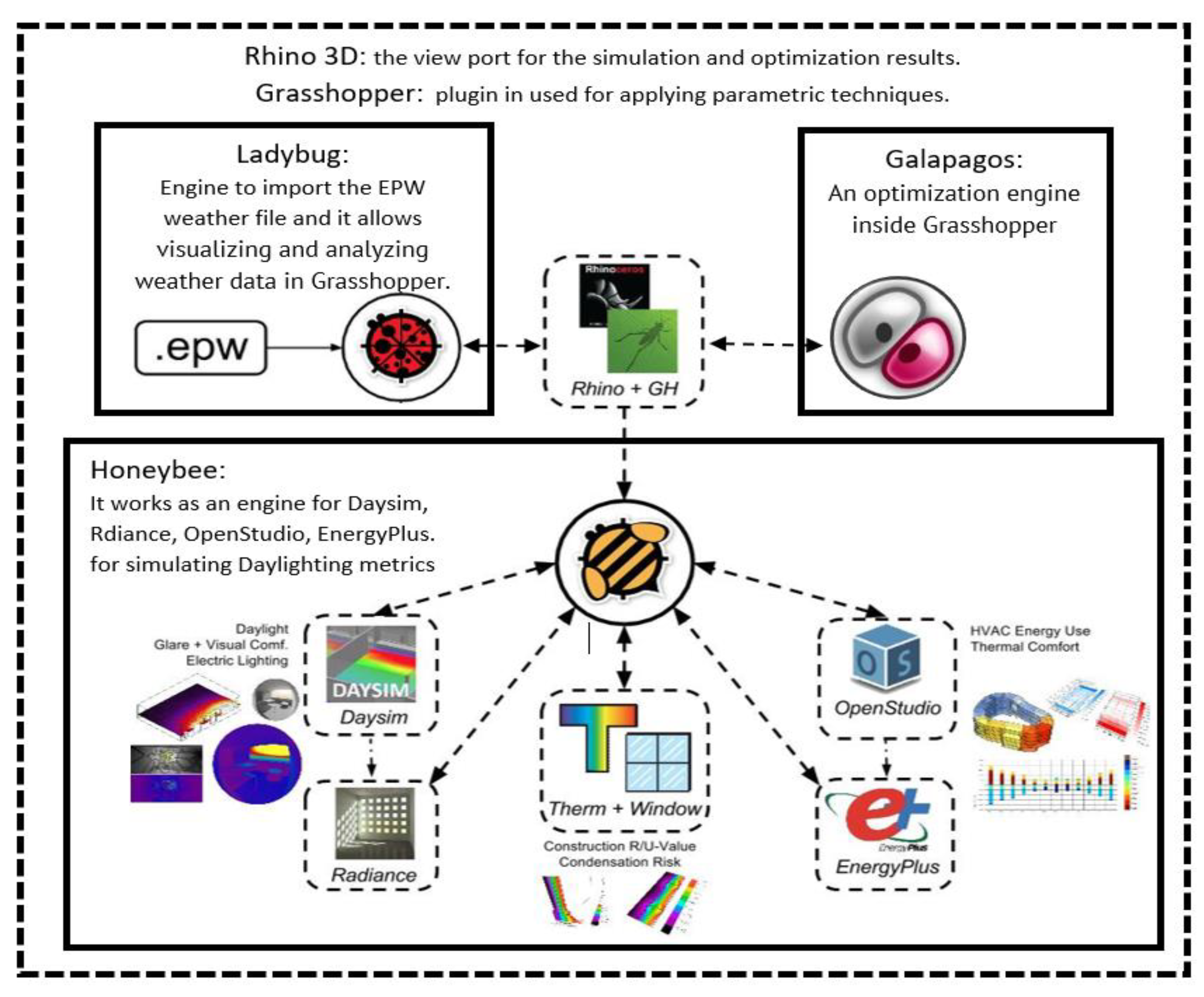
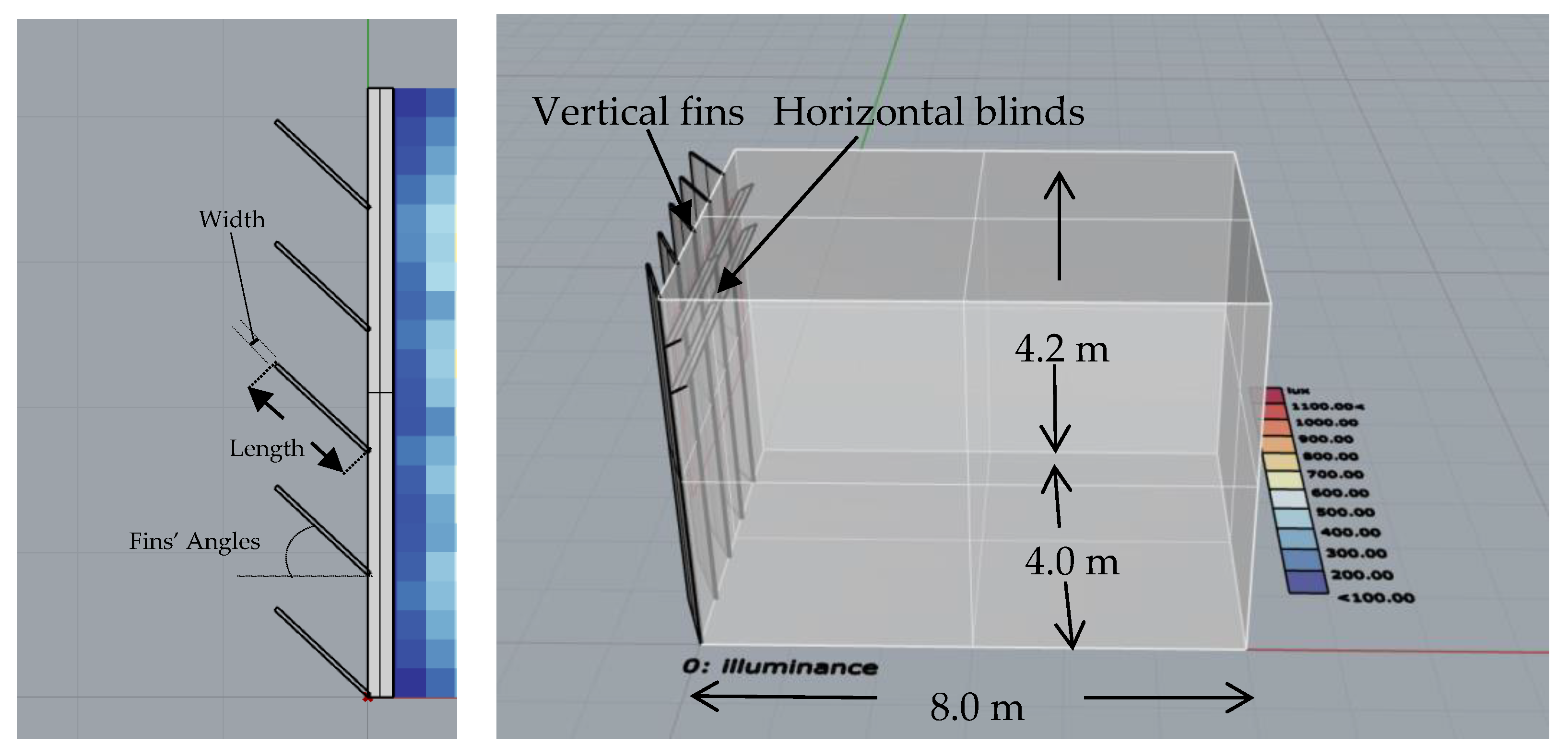
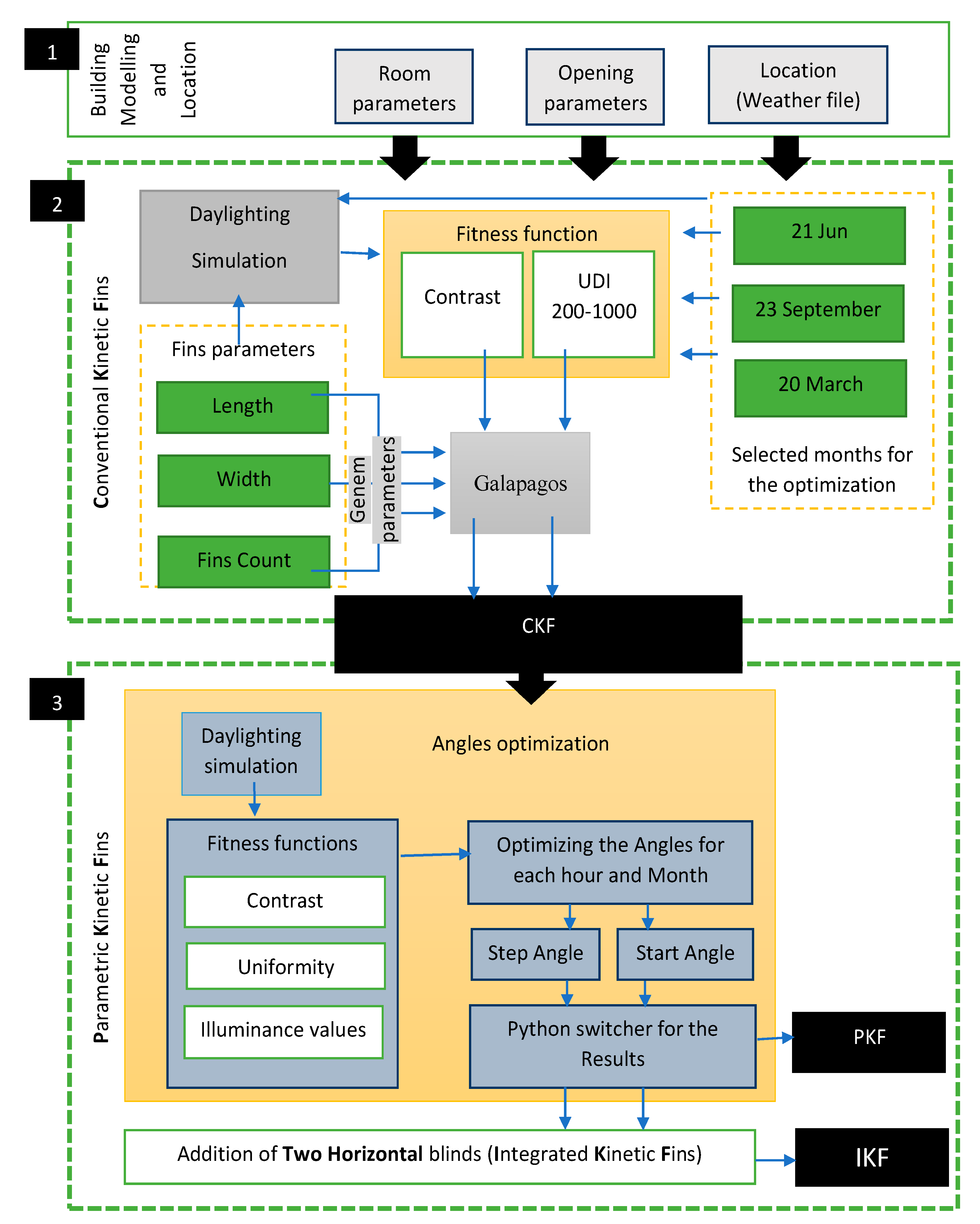
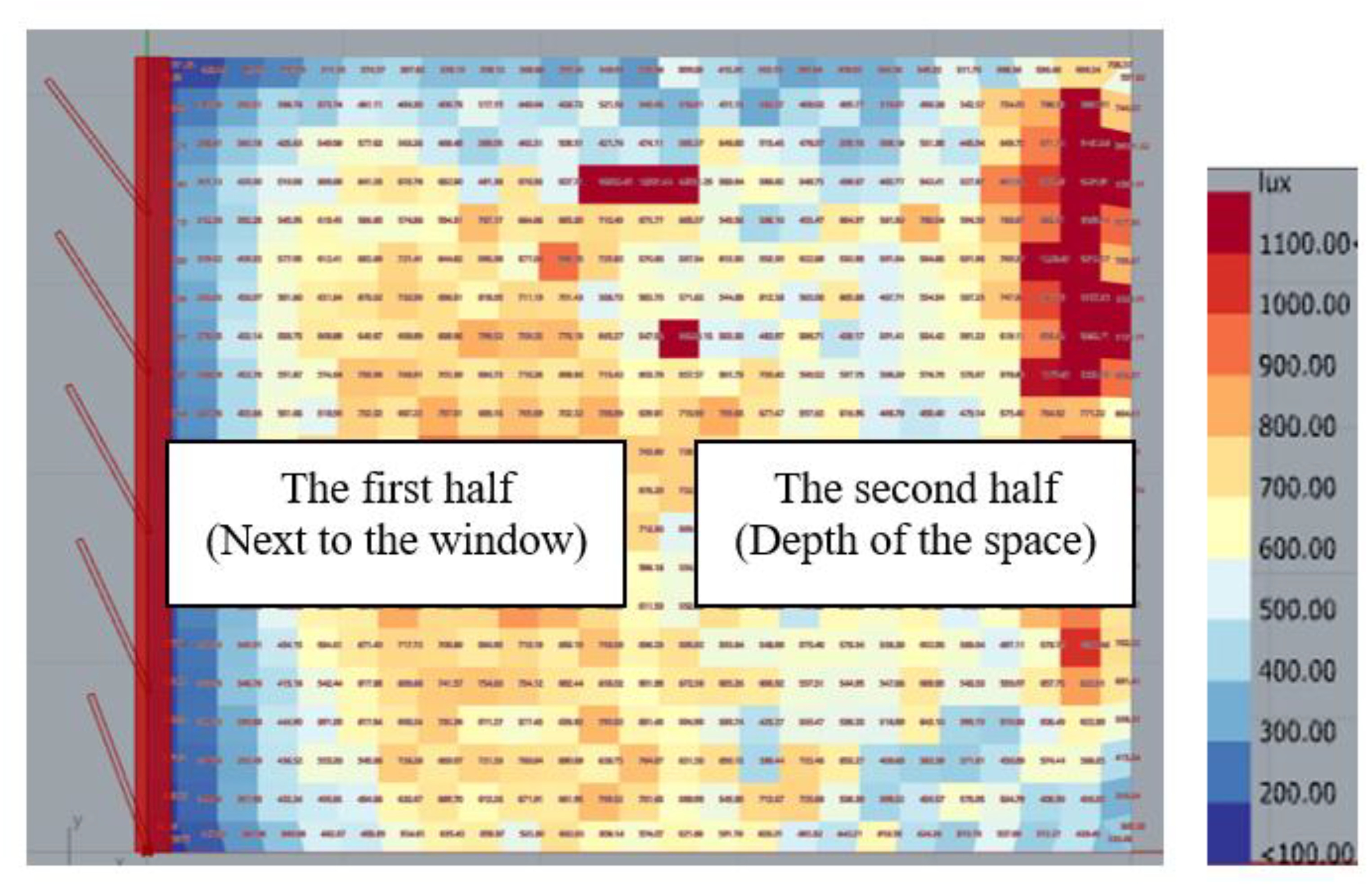
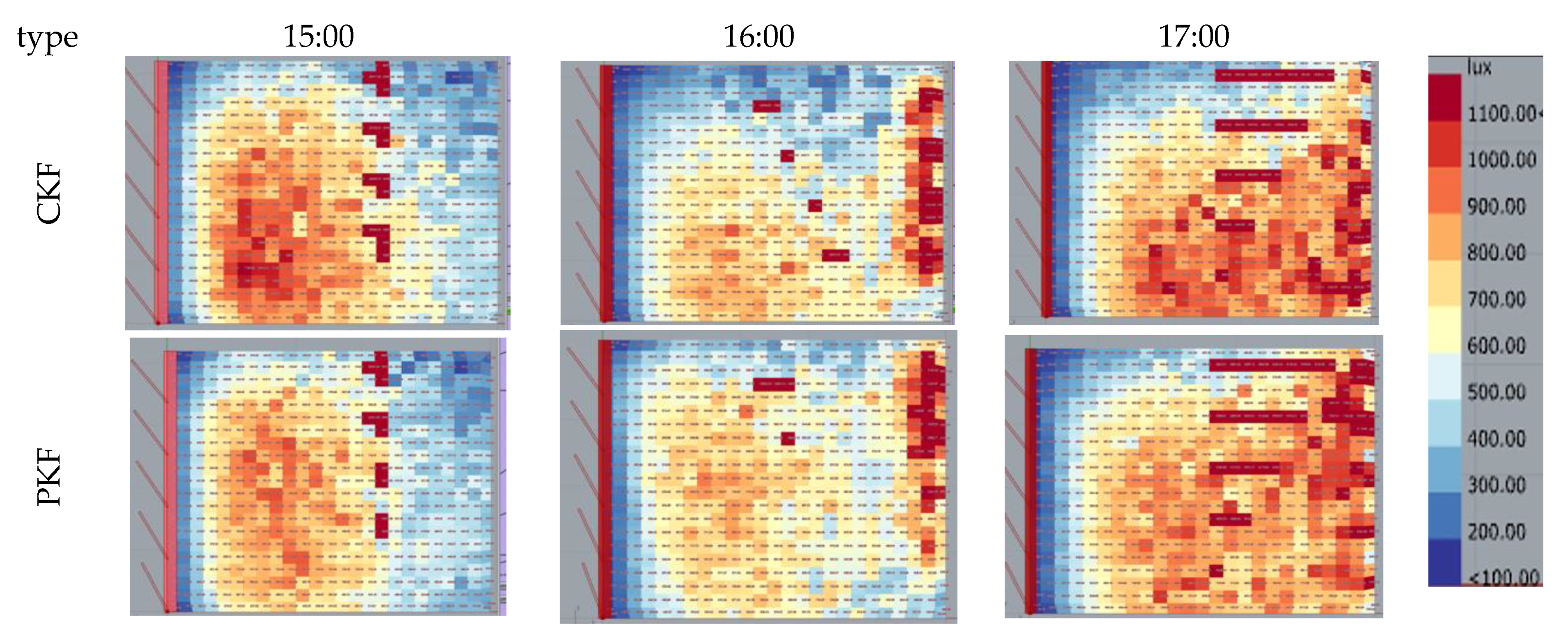


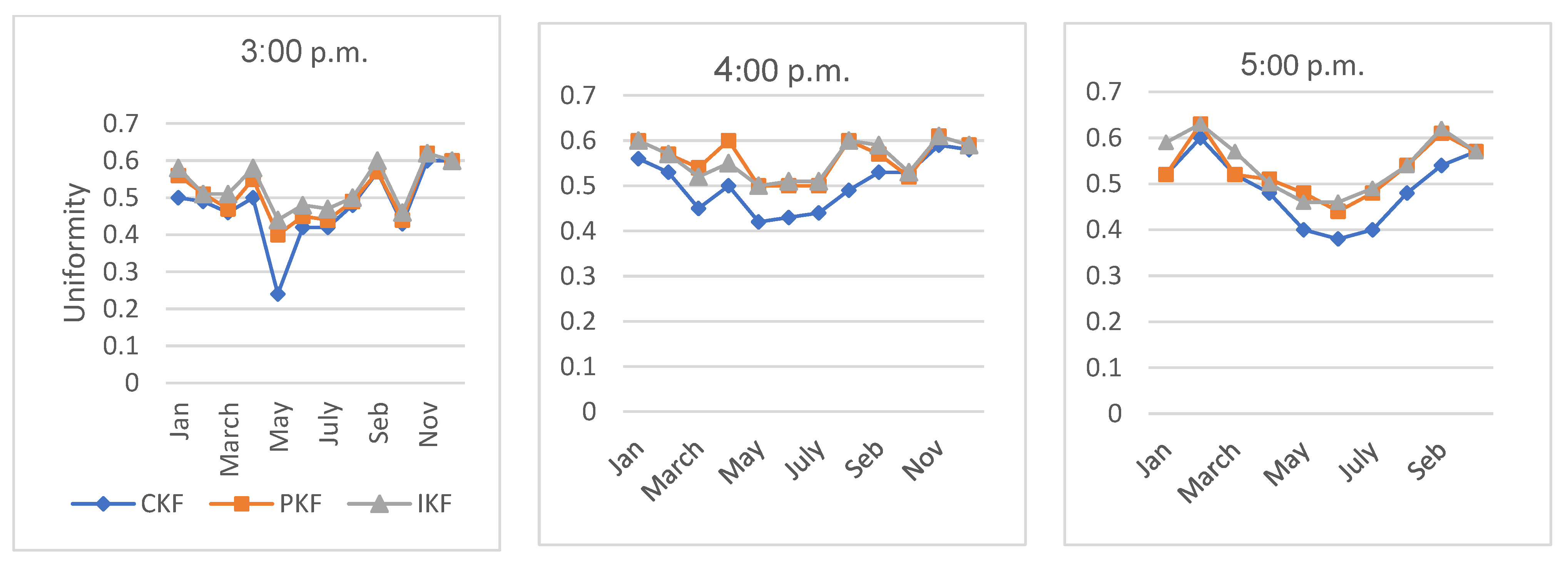

| Description | Optimization Parameters | ||
|---|---|---|---|
| Fix Parameters | Variable Parameters | ||
| Control | Optimizing fins’ dimensions. |
|
|
| CKF | The conventional kinetic fins have similar angles for all fins. |
|
|
| PKF | Every single fin in the parametric kinetic fins has a unique rotation angle. |
|
|
| IKF | The Integrated Kinetic Fins are similar to PKF with the addition of two extra horizontal blinds. |
|
|
| 21 March | 21 June | 21 September | A | ||||||||||||||||||||||||||||
|---|---|---|---|---|---|---|---|---|---|---|---|---|---|---|---|---|---|---|---|---|---|---|---|---|---|---|---|---|---|---|---|
| Width m | 0.04 | 0.04 | 0.023 | 0.047 | 0.042 | 0.044 | 0.045 | 0.023 | 0.04 | 0.045 | 0.037 | 0.037 | 0.034 | 0.038 | 0.036 | 0.037 | 0.033 | 0.03 | 0.036 | 0.029 | 0.03 | 0.03 | 0.03 | 0.028 | 0.03 | 0.03 | 0.037 | 0.03 | 0.03 | 0.029 | 0.035 |
| Length m | 0.77 | 0.76 | 0.98 | 0.76 | 0.78 | 0.77 | 0.92 | 0.98 | 0.92 | 0.77 | 0.73 | 0.73 | 0.74 | 0.73 | 0.75 | 0.72 | 0.75 | 0.75 | 0.75 | 0.83 | 0.84 | 0.83 | 0.84 | 0.83 | 0.81 | 0.83 | 0.84 | 0.69 | 0.86 | 0.83 | 0.08 |
| count | 6 | 5 | 6 | 6 | 6 | 5 | 5 | 5 | 5 | 5 | 5 | 5 | 5 | 5 | 5 | 5 | 5 | 5 | 5 | 5 | 4 | 5 | 5 | 5 | 5 | 5 | 5 | 6 | 5 | 5 | 5 |
| January | February | March | April | May | June | |||||||||||||||||||
|---|---|---|---|---|---|---|---|---|---|---|---|---|---|---|---|---|---|---|---|---|---|---|---|---|
| Time | 14:00 | 15:00 | 16:00 | 17:00 | 14:00 | 15:00 | 16:00 | 17:00 | 14:00 | 15:00 | 16:00 | 17:00 | 14:00 | 15:00 | 16:00 | 17:00 | 14:00 | 15:00 | 16:00 | 17:00 | 14:00 | 15:00 | 16:00 | 17:00 |
| Start angle | 30° | 55° | 45° | 15° | 68° | 60° | 60° | 40° | 65° | 62° | 74° | 60° | 65° | 68° | 70° | 65° | 70° | 75° | 75° | 75° | 73° | 72° | 78° | 76° |
| Step angle | 4 | 7 | 7 | 4 | 4.5 | 5.5 | 7 | 3 | 7 | 5 | 7 | 5 | 8 | 5 | 4 | 2 | 5 | 5 | 5 | 4.5 | 4 | 5 | 6 | 5 |
| Fins Angels | 30, 26, 22, 18, 14 | 55, 48, 41, 34, 27 | 45, 38, 31, 24, 17 | 15, 11, 7, 3, 1 | 68, 63.5, 59, 54.5, 50 | 60, 54.5, 49, 43.5, 38 | 60, 53, 46, 39, 32 | 40, 37, 34, 31, 28 | 65, 58, 51, 44, 37 | 62, 57, 52, 47, 42 | 74, 67, 60, 53, 46 | 60, 55, 50, 45, 40 | 65, 57, 49, 41, 33 | 68, 63, 58, 53, 48 | 70, 66, 62, 58, 54 | 65, 63, 61, 59, 57 | 70, 65, 60, 55, 50 | 75, 70, 65, 60, 55 | 75, 70, 65, 60, 55 | 75, 70.5, 66, 61.5, 57 | 73, 69, 65, 61, 57 | 72, 67, 62, 57, 52 | 78, 72, 66, 60, 54 | 76, 71, 66, 61, 56 |
| July | August | September | October | November | December | |||||||||||||||||||
| Time | 14:00 | 15:00 | 16:00 | 17:00 | 14:00 | 15:00 | 16:00 | 17:00 | 14:00 | 15:00 | 16:00 | 17:00 | 14:00 | 15:00 | 16:00 | 17:00 | 14:00 | 15:00 | 16:00 | 17:00 | 14:00 | 15:00 | 16:00 | 17:00 |
| Start angle | 67° | 70° | 72° | 80° | 55° | 63° | 70° | 68° | 45° | 60° | 64° | 58° | 60° | 45° | 50° | 15° | 40° | 40° | 25° | 0° | 28° | 25° | 15° | 0° |
| Step angle | 4.5 | 4 | 4.5 | 6 | 4 | 3 | 4 | 3.5 | 5 | 5 | 5 | 5 | 7 | 6 | 5 | 0 | 7 | 7 | 5 | 0 | 4 | 4 | 0.2 | 0 |
| Fins Angels | 67, 62.5, 58, 53.5, 49 | 70, 66, 62, 58, 54 | 72, 67.5, 63, 58.5, 54 | 80, 74, 68, 62, 56 | 55, 51, 47, 5, 43, 39 | 63, 60, 57, 54, 51 | 70, 66, 62, 58, 54 | 68, 64.5, 61, 57.5, 54 | 45, 40, 35, 30, 25 | 60, 55, 50, 45, 40 | 64, 59, 54, 49, 44 | 58, 53, 48, 43, 38 | 60, 53, 46, 39, 32 | 45, 39, 33, 27, 21 | 50, 45, 40, 35, 30 | 15, 15, 15, 15, 15 | 40, 33, 26, 19, 12 | 40, 33, 26, 19, 12 | 25, 20, 15, 10, 5 | 0, 0, 0, 0, 0 | 28, 24, 20, 16, 12 | 25, 21, 17, 13, 9 | 15, 14.8, 14.6, 14.4, 14.2 | 0, 0, 0, 0, 0 |
Disclaimer/Publisher’s Note: The statements, opinions and data contained in all publications are solely those of the individual author(s) and contributor(s) and not of MDPI and/or the editor(s). MDPI and/or the editor(s) disclaim responsibility for any injury to people or property resulting from any ideas, methods, instructions or products referred to in the content. |
© 2023 by the authors. Licensee MDPI, Basel, Switzerland. This article is an open access article distributed under the terms and conditions of the Creative Commons Attribution (CC BY) license (https://creativecommons.org/licenses/by/4.0/).
Share and Cite
Fahmy, M.K.; Eltaweel, A.; Rizi, R.A.; Imani, N. Integrated Kinetic Fins for Western Facades in Territories with Low Solar Altitudes. Buildings 2023, 13, 782. https://doi.org/10.3390/buildings13030782
Fahmy MK, Eltaweel A, Rizi RA, Imani N. Integrated Kinetic Fins for Western Facades in Territories with Low Solar Altitudes. Buildings. 2023; 13(3):782. https://doi.org/10.3390/buildings13030782
Chicago/Turabian StyleFahmy, Marwa Kamal, Ahmad Eltaweel, Rana Abdollahi Rizi, and Negin Imani. 2023. "Integrated Kinetic Fins for Western Facades in Territories with Low Solar Altitudes" Buildings 13, no. 3: 782. https://doi.org/10.3390/buildings13030782
APA StyleFahmy, M. K., Eltaweel, A., Rizi, R. A., & Imani, N. (2023). Integrated Kinetic Fins for Western Facades in Territories with Low Solar Altitudes. Buildings, 13(3), 782. https://doi.org/10.3390/buildings13030782









